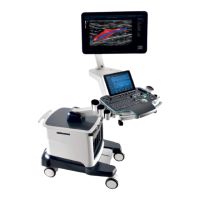9 Contrast Imaging
Operator’s Manual 9 - 5
• In case of inaccuracy of the data, do not adjust the depth and the pan-zoom when saving the
cine. Also, during image scanning, ask the patient to hold breath for several seconds, and keep
the probe still until the image is frozen.
• If the contrast signal inside the selected ROI does not meet the requirements of gamma fitting
condition, that is the bulleting injection, curve fitting may not be available.
Contrast Imaging QA adopts time-intensity analysis to obtain perfusion quantification information
of velocity flow. This is usually performed on both suspected tissue and normal tissue to get
specific information of the suspected tissue.
Perform the following procedure:
1. Perform image scanning, freeze the image and select a range of images for analysis; or select a
desired cine loop from the stored images.
The system sets the starting time and ending time of the cine to be first frame and last frame of
QA analysis range.
1Contrast
cineloop window
Sample area: indicates sampling position of the analysis curve. The
sample area is color-coded, 8 (maximum) sample areas can be indicated.
2 B cineloop
window
Sample areas are linked in the contrast cineloop window and B cineloop
window.
3 Time-intensity
curve
• Y axis represents the intensity (unit: dB), while X axis represents the
time (unit: s).
• Frame marker: a white line that is perpendicular to the X axis, can be
moved horizontally left to right (right to left) by using the trackball.
• Click the check box beside the ROI to set if to hide or to display the
QA curve.
• You can get the current X/Y axis value by moving the cursor onto one
point on the curve; and if you press <Set> at this time, the frame
marker will move to the spot.

